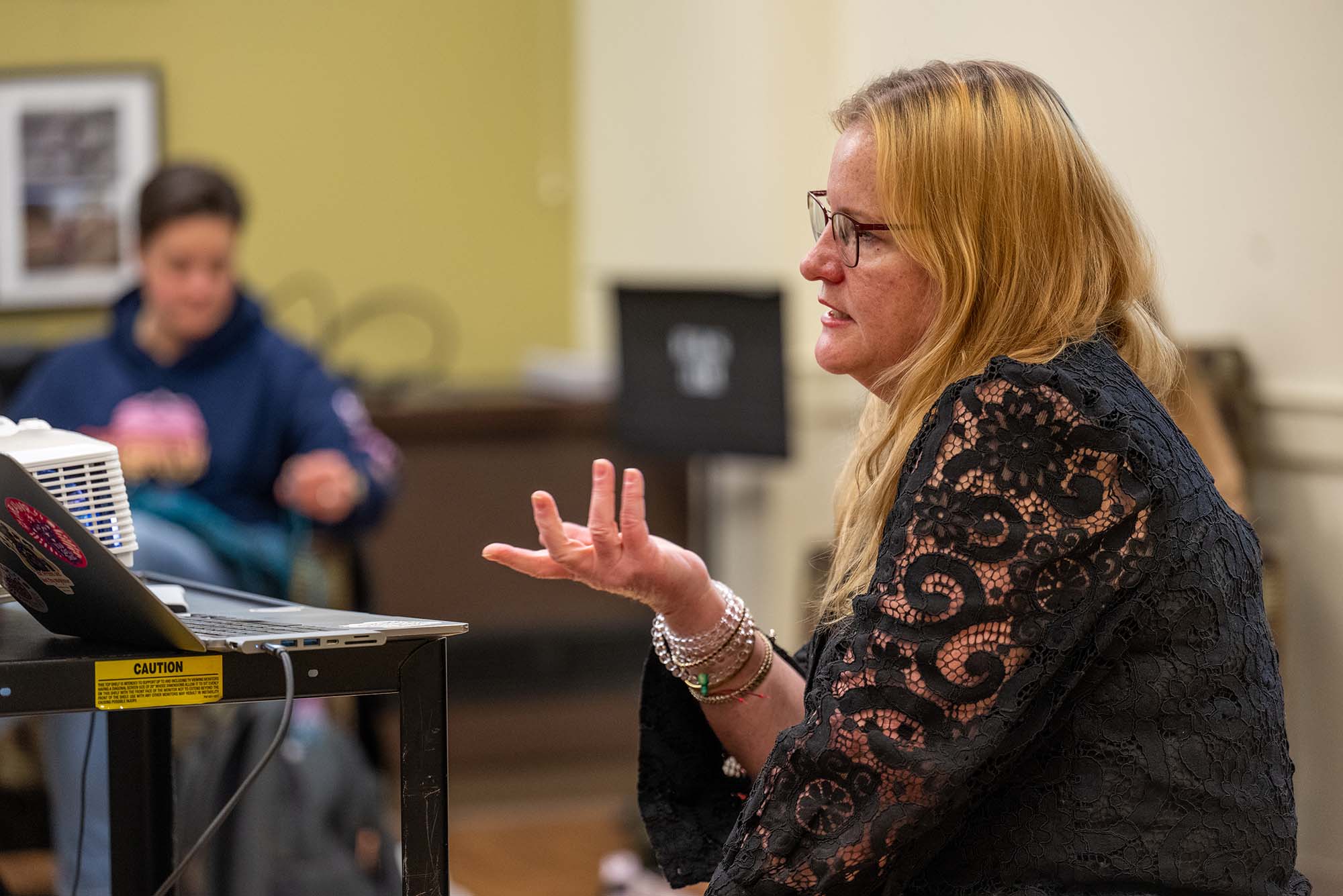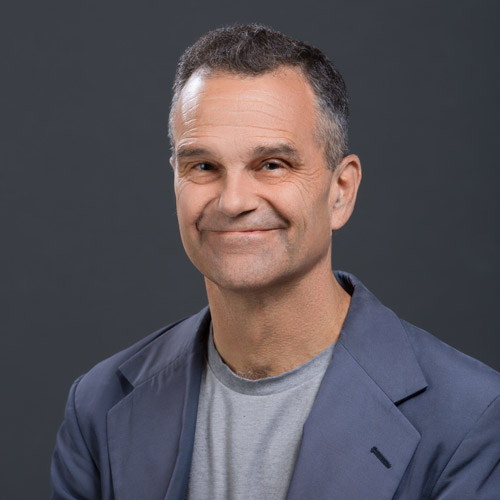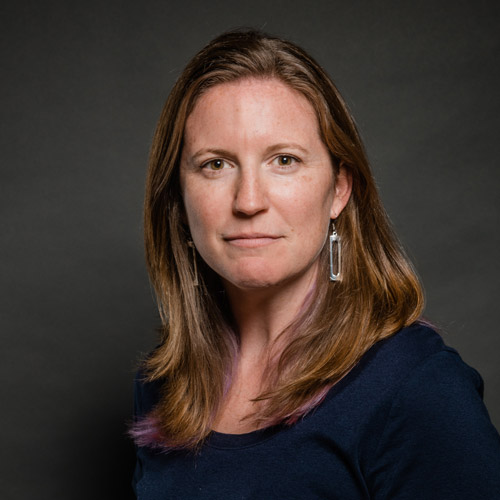School of Theology Adjusts to New Reality: Ministry Expands Beyond Church
BU’s oldest school revises curriculum for first time in a decade

Shelly Rambo, who teaches STH’s Introduction to Chaplaincy class, sat on the steering committee that revamped the curriculum and predicts such revisions will be more frequent going forward.
School of Theology Adjusts to New Reality: Ministry Expands Beyond Church
BU’s oldest school revises curriculum for first time in a decade
The patient had been fighting a critical illness amid a confusing thicket of medical jargon and the reality of her mortality. She entered hospice care only after being assured that her caregivers would help her squeeze the most out of every day rather than focus on death. At one point, Chaplain Kathleen Willis (STH’16) visited her for Reiki, a Japanese healing technique involving the laying on of hands.
“When we finished the session, she looked at me,” Willis recalls. “She was like, ‘I’m not afraid anymore.’” She died a week later, Willis tells students in Introduction to Chaplaincy, taught by Shelly Rambo, a professor of theology at Boston University’s School of Theology.
Willis, now a chaplain at Tufts Medical Center and in private practice, offers other peeks behind the curtain of her work—from when a chaplain must be present for patients to when she must hand off that baton. “Fetal demise can be hard for me sometimes, because I lost my own son,” she confides. “He was seven weeks old.”
Her rapt listeners are the faces of America’s new religious reality. Rambo estimates that half the students in her class plan to forgo traditional careers as church ministers and pastors to become chaplains, serving communities in flux: hospitals, campuses, prisons, the military. The remaining half are what Sujin Pak, dean of STH, calls “seekers,” uncertain of their postgraduation path. Some may choose chaplaincy, others may opt for careers with nonprofits, and others, Pak says, may hope to detect life’s purpose through their studies.
BU’s oldest school has adjusted to this new reality. STH instituted its first curriculum revision in more than a decade this academic year.
The changes, says Rambo, a member of the steering committee that oversaw the revisions, centered on STH’s bread-and-butter programs: the three-year master of divinity degree (MDiv), historically for aspiring ministers, and the two-year master of theological studies (MTS), typically for budding academics, though some denominations require it as a credential.
The reform involves three key changes, Pak says:
- 3 new tracks of study, down from 11, that students elect for their time at STH: ecclesial (for traditional, clergy-bound students), chaplaincy, and an “open” track for the seekers;
- a pared-down core curriculum, with 7 core requirements instead of the previous 14, married to customizable electives in each track (students must take 5 electives during their studies); and
- four options to satisfy each core class requirement, with at least one option each focused on ecclesial ministry and chaplaincy with interfaith content, “to lean into our both-and mission in service, both to the church and to broadened uses of the MDiv,” says Pak.
“Most all seminaries and theological schools are offering a very traditional curriculum” for church-bound ministers, she says, “and that’s fine. We certainly want to maintain that commitment,” as one quarter of STH students choose that route. But “the number of people pursuing theological education primarily to be a pastor of a church is decreasing,” a shift Pak attributes to several factors, from the decline of mainline denominations to cratering trust of institutions generally.
The reform hews to the wisdom that less is more, with its fewer tracks and core courses, because STH listened to its 300 students and 4,000 alumni, who were surveyed as part of the revision. Leaders found broad agreement that under the old curriculum, the first year of study was “too rigid and demanding,” Pak says, starting with having to get a jump on those 14 core courses. “Having half or more of their coursework taken by requirements—that is not what students are wanting these days. They want a lot more customizability, a lot more flexibility.”
The seven remaining cores, required of students on all three tracks, cover the Hebrew Bible, the New Testament, Christian history, theology, ethics, spiritual care, and practical theology.
“The idea is that you can benefit from these classes, whichever of the three tracks you’re in,” says Pak. “These seven requirements are the core of what we think an MDiv and MTS are supposed to be. The new core classes are organized to allow for more elective space, so that students have increased opportunity to [pursue] their passions and big questions earlier in their studies.”

The new curriculum required the creation of only a few new courses; “we leaned into what we already had and thought about using them more strategically,” Pak says. An exception is history. “In the previous curriculum, History of Christianity was taught together with the introduction to Christian theology in a two-semester sequence,” says Christopher Boyd Brown, an STH associate professor of church history. The introductory theology courses and history of Christianity are now taught separately.
“STH is, at its core, Christian,” says Pak, the granddaughter, daughter, and niece of United Methodist elders and deacons. But “we’re also very open to interfaith. …We understand that the kind of Christianity we want to be is that very hospitable, humble, Invitational, committed-to-social-justice kind of Christianity.”
Jenesis Andrews-Kendale (STH’24), another steering committee member, would have welcomed the new curriculum during her pre-revision student days. During committee meetings, she recalls, she pushed for “a core curriculum that meets field standards and elective prereqs, building a more flexible degree program for MDiv students and reworking the introductory courses. I hope the curriculum review has made opportunities like that available to more STH students.” A seeker, Andrews-Kendale is mulling her career options.
Bright Nogoh (STH’26), working for his MDiv as an aspiring campus chaplain, studied under both the old and the new curricula. The latter has “made it much easier for me to explore other areas that I couldn’t have done, that could have been much more difficult for me under the old curriculum,” with its numerous core requirements. Beyond chaplaincy, he says, “I have the liberty to explore areas like world Christianity courses, and then I am also taking some courses in Methodist studies.”
Mustard Uzu (STH’25), who plans to become an Anglican military chaplain, completed the former 14-core requirement before this, his last year, which is governed by the new regimen. He has a certain if-only sentiment: “Some courses I would have loved to do, some courses I did that were compulsory for my program I would have chosen not to take. Maybe I would have changed them to different kinds of courses.”
Even the Rev. Alicia Velez Stewart (STH’19), another steering committee member and pastor of the Weston (Mass.) United Methodist Church (UMC), says she would have benefited from the new curriculum, though she chose the traditional ministry route.
“The new curriculum offers more freedom to choose classes that benefit deacons as well as elder-track students in the UMC,” she says. “This is vital, as deacons and bi-vocational elders/pastors become more and more the future of the church. The previous curriculum had a very narrow focus for pastoral theology and ordination-bound students, and the changes allow now for more flexibility.”
Will this curriculum be the next 15 years? No, we’re going to revisit it more often. We have more nimbleness in terms of thinking.
STH will assess the curriculum’s rollout. “If we see things that are cropping up that are a problem, let’s have a conversation and see whether we need to rethink a few things,” Pak says. “For example, I teach a seminar on the history of biblical interpretation,” and given the reduction in core courses, “I can’t assume now that everybody who comes into that has had the history of Christianity.” For students who might not have heard of Martin Luther or Augustine or Origen, “I actually now build in a mini-lecture for every class—here’s some background or key themes to think about—to help them frame it.”
“Will this curriculum be the next 15 years?” Rambo asks rhetorically. “No, we’re going to revisit it more often. We have more nimbleness in terms of thinking.”


Comments & Discussion
Boston University moderates comments to facilitate an informed, substantive, civil conversation. Abusive, profane, self-promotional, misleading, incoherent or off-topic comments will be rejected. Moderators are staffed during regular business hours (EST) and can only accept comments written in English. Statistics or facts must include a citation or a link to the citation.